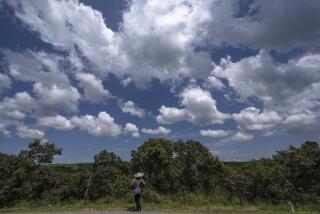Current of anger in the Ganges
- Share via
ALLAHABAD, INDIA — Among believers, the river has many names: The Pure. Destroyer of Sin. Light Amid the Darkness of Ignorance. But mostly they call it “Ganga Ma” -- Mother Ganges -- and they worship it with a blinding intensity.
They worship it despite the islands of garbage that float down its path, and the tons of chemicals dumped in it. They worship it despite the quarter of a billion gallons of sewage poured into it every day, spreading illness among the 350 million people -- one-twentieth of the world’s population -- who live in its watershed.
For Hindus, the Ganges is a living goddess, capable of washing away sin. But its epic troubles are grabbing the attention of the faithful.
“She is my mother,” said Chandra Madash, a holy man squatting by a fire on a cold night. His beard was long and dirty, his clothing frayed, his voice gravelly. He has spent nearly his entire life in a remote Hindu monastery. “Even if she is dirty, I love my mother.”
Then he asked: “How can people do this to her?”
As millions gathered for a Hindu festival that pays homage to the river, a group of Hindu holy men filed lawsuits, called news conferences and organized protests. A handful threatened suicide.
“The government has promised us they would stop dirty water from flowing into Mother Ganges, but it’s still being done,” Narendranand Saraswati, a monastery leader, told thousands of cheering followers gathered by the Ganges. “We want the entire country to know we will not stop until the river is clean!”
These are not your typical environmental activists.
In India, they are known collectively as “sadhus,” a sweeping term that includes tens of thousands of Hindu holy men, from revered leaders to charlatans who prey on the lost and confused.
Although a handful are famous for their profligacy -- luxury cars, fur coats and rumors of mistresses -- most live poor and celibate.
Many spend their days wandering India’s streets, begging for food and owning little beyond their clothes.
But among the loose coalition of sadhu leaders speaking out about the Ganges, some have potent political connections. In a country with 890 million Hindus, they are part of wide, informal power networks.
But while their protests often spark headlines and short-term responses -- this year, the government opened dams to increase the Ganges’ flow during the festival, creating brief river surges -- a serious cleanup would have to confront decades of official failure.
“The government listens to us during the Kumbh Mela,” said Binduji Maharaj, a sadhu leader. “But unfortunately, when it is over they tend to forget us.”
Every six years, millions of pilgrims gather for the Ardh Kumbh Mela, or Half Grand Pitcher Festival, held where the Ganges and Yamuna rivers -- along with the mythical Saraswati River -- come together.
Hindu mythology says gods and demons once fought a war over the nectar of immortality, spilling some at the rivers’ confluence.
As many as 70 million people were expected for this year’s 45-day festival, which ended Feb. 16. Even relatively quiet days bring tens of thousands of pilgrims to the riverbanks.
They stand in the slow-moving grey-green water close to the shoreline, scooping water with cupped hands and pouring it over their heads.
As loudspeakers blare hymns, boys peddle religious knickknacks -- incense sticks, tiny clay lanterns -- and milk at 11 cents a ladle.
“How can the Ganges be dirty?” asked Thiruven Shankar, the joy obvious in his voice as he joined the throngs. “We drink it in, we bathe in it, and we worship its waters.”
But scientists say sewage has devastated the 1,550-mile river, which spills from a Himalayan glacier and cuts through India’s plains before flowing into the Bay of Bengal. Scientists have found places with a fecal bacteria count nearly 4,000 times the World Health Organization standard for bathing.
“We all have faith in our rivers, we all worship them. But at the end of the day there’s a reality: India’s cities are growing, its population is growing, and we don’t have a proper sewage strategy,” said Suresh Babu, a river specialist with the Center for Science and Environment, a prominent environmental group.
The medical effects are clear: millions of cases of disease, from amebic dysentery to hepatitis. By some estimates, one person dies every minute of waterborne disease in the Ganges basin.
In the late 1980s, the Indian government vowed to clean the river, launching its Ganges Action Plan and spending $300 million since then. The plan’s failures are famous. The federal environment minister noted recently that the program had achieved very little -- but said $1.5 billion more was needed.
Repeatedly, the government has left promises unfilled, including to a group of sadhus who launched an antipollution hunger strike during the last Allahabad festival.
“These officials have done nothing,” said Veer Bhadra Mishra, sitting outside his home in the riverside city of Varanasi.
Mishra is the leader of an important Hindu temple, as well as a professor of engineering and a longtime environmental activist.
He doubts the recent attention will accomplish much. Too many holy men have ties to corrupt politicians, he says, and too few understand the science. India also has a habit, he adds, of forgetting its environmental vows.
But giving up isn’t an option.
“These officials must be humiliated!” the normally soft-spoken Mishra said, his voice rising sharply. “They must be embarrassed that they are allowing the Ganges to be dirtied!”
More to Read
Sign up for Essential California
The most important California stories and recommendations in your inbox every morning.
You may occasionally receive promotional content from the Los Angeles Times.










